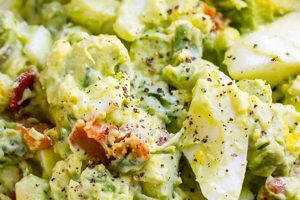This dish typically combines hard-boiled eggs, mayonnaise, and a variety of vegetables and seasonings common in Korean cuisine. Green onions, carrots, and onions are often incorporated, while gochujang (Korean chili paste), soy sauce, sesame oil, and toasted sesame seeds contribute a distinct flavor profile that differentiates it from standard egg salad. Variations might include adding ingredients like kimchi, crab sticks, or different types of mustard for extra depth.
The blend of textures and savory, spicy, and subtly sweet flavors makes this variation a popular side dish, sandwich filling, or topping for rice. It offers a nutritious and convenient way to incorporate eggs into a meal, providing protein and essential vitamins. The fusion of traditional egg salad components with Korean flavors reflects the ongoing evolution of culinary traditions and the adaptation of dishes to incorporate local ingredients and preferences. This dish serves as a bridge between familiar comfort food and the vibrant world of Korean cuisine.
The following sections will delve deeper into specific variations of this egg salad, providing detailed ingredient lists, step-by-step instructions, and helpful tips for achieving optimal results. Nutritional information and suggestions for serving will also be explored.
Tips for Preparing Korean Egg Salad
Optimizing the preparation process ensures a flavorful and texturally satisfying egg salad experience. Attention to detail in each step contributes significantly to the final product.
Tip 1: Perfectly Cooked Eggs: Achieve ideal yolk texture by bringing eggs to a boil in cold water. Once boiling, remove from heat and let sit covered for 10-12 minutes, depending on egg size. This method prevents overcooking and promotes a creamy, not rubbery, yolk.
Tip 2: Finely Chopped Ingredients: Consistent texture is key. Ensure vegetables and other additions are finely chopped for even distribution of flavor and a pleasant mouthfeel.
Tip 3: Gochujang Adjustment: Gochujang’s spiciness varies. Start with a smaller amount and adjust to taste preference, avoiding overpowering the other flavors.
Tip 4: Sesame Oil Enhancement: Toasted sesame oil adds a deeper, nuttier aroma. A small amount greatly enhances the overall flavor profile.
Tip 5: Freshness Matters: Use fresh, high-quality ingredients. Fresh green onions and crisp vegetables elevate the overall taste and visual appeal.
Tip 6: Chilling Time: Allow the egg salad to chill for at least 30 minutes before serving. This allows the flavors to meld and enhances the overall experience.
Tip 7: Creative Variations: Explore variations by incorporating ingredients like finely chopped kimchi, shredded crab sticks, or a touch of Dijon mustard. These additions provide unique flavor dimensions.
By following these tips, one can elevate a simple egg salad into a flavorful and authentic Korean-inspired dish. The resulting combination of textures and balanced flavors provides a delightful culinary experience.
The following section will conclude with serving suggestions and variations for incorporating this dish into various meals.
1. Hard-boiled Eggs
Hard-boiled eggs constitute the foundational ingredient in Korean egg salad, providing the primary protein source and influencing texture and flavor dynamics. Proper preparation of these eggs is crucial for achieving the desired outcome.
- Cooking Method:
The method employed for hard-boiling eggs directly impacts the final texture and ease of peeling. Gentle boiling, followed by a resting period in hot water, yields yolks with a creamy consistency, avoiding a dry, crumbly texture. This method also facilitates easier shell removal, a critical step for achieving a smooth, aesthetically pleasing egg salad. Overcooking can result in a rubbery texture and a greenish ring around the yolk, negatively affecting both taste and appearance.
- Yolk Consistency:
The consistency of the yolk plays a vital role in the overall texture of the egg salad. A slightly soft, creamy yolk contributes to a smoother, more cohesive mixture, binding the other ingredients effectively. Conversely, overly hard yolks can result in a drier, less palatable salad.
- Freshness:
Fresh eggs are essential for both flavor and food safety. Fresh eggs peel more easily and possess a cleaner flavor that enhances the overall taste of the egg salad. Using older eggs can lead to difficulties in peeling and may introduce off-flavors that detract from the final product.
- Chopping Technique:
The way the hard-boiled eggs are chopped influences the final presentation and mouthfeel of the egg salad. Evenly sized pieces create a uniform texture, ensuring consistent flavor distribution. While some recipes call for coarsely chopped eggs, finely chopped eggs create a smoother, more refined texture that blends seamlessly with the other ingredients.
The careful preparation of hard-boiled eggs, from cooking method to chopping technique, directly influences the overall quality and enjoyment of Korean egg salad. Attention to these details ensures a harmonious blend of flavors and textures, elevating this simple dish into a culinary delight.
2. Mayonnaise base
Mayonnaise serves as the binding agent in Korean egg salad, influencing texture, flavor, and overall palatability. Its creamy consistency coats the other ingredients, creating a cohesive mixture while contributing a subtle tanginess that balances the spiciness of the gochujang and the savory notes of the other seasonings. The quality and type of mayonnaise used can significantly impact the final result. A richer, thicker mayonnaise creates a denser, creamier salad, while a lighter mayonnaise results in a fluffier texture. Using Japanese mayonnaise, known for its slightly sweeter and tangier profile, adds an authentic touch.
The amount of mayonnaise used also plays a crucial role in determining the final consistency. Too much mayonnaise can result in an overly rich and heavy salad, while too little can lead to a dry, crumbly texture. Finding the right balance is essential for achieving the desired consistency and optimal flavor distribution. The mayonnaise base also acts as a canvas for the other flavors, allowing the spiciness of the gochujang, the savoriness of the soy sauce, and the aromatics of the sesame oil to blend harmoniously. This balance of flavors creates a complex and satisfying taste profile that distinguishes Korean egg salad from its Western counterparts.
Understanding the role of mayonnaise in Korean egg salad allows for informed choices regarding type and quantity, ultimately contributing to a superior culinary outcome. Achieving the desired balance of flavors and textures hinges on recognizing the mayonnaise base as more than just a binding agent; it’s a key component that influences the overall sensory experience.
3. Gochujang (Korean chili paste)
Gochujang, a fundamental ingredient in Korean cuisine, plays a pivotal role in defining the distinct flavor profile of Korean egg salad. This fermented chili paste contributes a complex interplay of sweet, savory, and spicy notes, differentiating it from traditional egg salad preparations. The depth of flavor derived from gochujang stems from its unique fermentation process, involving glutinous rice, fermented soybeans, red pepper flakes, and salt. This process cultivates a nuanced flavor profile that adds both heat and umami to the egg salad. The quantity of gochujang used dictates the level of spiciness, allowing for customization based on individual preferences. A measured incorporation of gochujang ensures it complements, rather than overwhelms, the other ingredients. For instance, a milder application allows the sweetness of the mayonnaise and the freshness of the vegetables to shine through, while a more generous amount creates a bolder, spicier experience.
Gochujang’s significance extends beyond mere heat; its complex flavor profile enhances the overall sensory experience of the dish. The fermentation process imparts a depth of flavor that elevates the egg salad beyond a simple combination of ingredients. This complexity allows the dish to stand alone as banchan (a side dish) or complement other Korean staples like bibimbap. Furthermore, gochujang contributes a vibrant red hue to the egg salad, enhancing its visual appeal. This visual element adds to the overall dining experience, making it more enticing and appetizing. The inclusion of gochujang exemplifies the fusion of tradition and innovation in modern Korean cuisine, demonstrating how traditional ingredients can be incorporated into familiar dishes to create novel culinary experiences.
Understanding the role of gochujang in Korean egg salad is crucial for appreciating its contribution to the dish’s unique character. Its balanced incorporation allows for a harmonious blend of flavors and textures, resulting in a culinary creation that exemplifies the dynamism of Korean gastronomy. The strategic use of gochujang highlights the potential for transforming a simple dish into a flavorful and culturally significant culinary experience. This understanding further illuminates the broader context of Korean cuisine, highlighting the importance of fermentation and the nuanced use of chili pastes in achieving complex flavor profiles. Adapting the quantity of gochujang provides flexibility for individual palates while maintaining the essence of Korean flavor.
4. Texture and Flavor Balance
Texture and flavor balance are integral to a successful Korean egg salad recipe. The interplay of contrasting yet complementary textures and flavors creates a dynamic sensory experience. Creamy egg yolks juxtaposed with crisp vegetables like finely diced onions, carrots, and scallions offer textural variety. This textural diversity prevents monotony, ensuring each bite offers a nuanced mouthfeel. The interplay of flavors, equally crucial, hinges on balancing the richness of mayonnaise, the subtle sweetness and heat of gochujang, the umami of soy sauce, and the aromatic nuttiness of sesame oil. A harmonious balance prevents any single flavor from dominating, resulting in a complex, layered taste profile. For example, the slight sweetness of the mayonnaise tempers the gochujang’s heat, while the soy sauce adds a savory depth that complements the other ingredients. This balance ensures the overall flavor profile remains harmonious and engaging.
Achieving this balance requires careful consideration of ingredient proportions and preparation techniques. Finely chopping vegetables ensures even distribution throughout the salad and contributes to a pleasant texture. Adjusting the amount of gochujang allows for tailoring the spice level to individual preferences while maintaining its essential flavor contribution. The quantity of mayonnaise also plays a crucial role; too much can create an overly rich and heavy salad, while too little can result in a dry, crumbly texture. Understanding these nuances allows for adjustments based on specific ingredient characteristics and desired outcomes. For example, using a slightly sweeter Japanese mayonnaise may necessitate reducing the added sugar to maintain overall balance.
Mastery of texture and flavor balance elevates Korean egg salad from a simple dish to a complex culinary experience. This mastery demonstrates a deeper understanding of Korean cuisine’s emphasis on balanced flavors and textures. It allows for adaptation and customization based on ingredient availability and personal preference, showcasing the dynamic nature of culinary practice. The ability to adjust and refine these elements demonstrates culinary expertise and contributes to a more satisfying and nuanced dining experience. This principle of balance extends beyond Korean egg salad, reflecting a broader culinary philosophy that emphasizes the harmonious interplay of tastes and textures in creating a well-rounded dish.
5. Fresh Ingredients
Ingredient freshness significantly impacts the overall quality of Korean egg salad. Freshness directly correlates with flavor intensity and optimal textural characteristics. Wilted scallions or less-than-crisp vegetables diminish the vibrant flavors and introduce undesirable textural elements. The delicate balance of flavors characteristic of this dish relies on the individual components’ peak freshness. For example, using fresh, pungent scallions provides a bright, oniony counterpoint to the richness of the mayonnaise and the heat of the gochujang. Similarly, crisp cucumbers or carrots contribute a refreshing crunch that enhances textural complexity.
Prioritizing fresh ingredients elevates the sensory experience. The vibrant flavors of fresh produce enhance the overall complexity and depth of the dish. Freshly prepared gochujang, if accessible, offers a more nuanced flavor profile compared to store-bought versions. The quality of the mayonnaise also plays a critical role; using fresh, high-quality mayonnaise enhances the creamy texture and overall flavor. Furthermore, fresh eggs, essential for proper emulsification and texture, contribute a clean taste that allows the other flavors to shine. The difference between using fresh ingredients and older, less vibrant ones is palpable in the final product.
Selecting fresh, high-quality ingredients demonstrates a commitment to culinary excellence. This commitment translates to a more vibrant and flavorful Korean egg salad that exemplifies the principles of balance and freshness central to Korean cuisine. While some ingredients, like gochujang, may have a longer shelf life, prioritizing freshness whenever possible yields superior results. This attention to detail, though seemingly minor, significantly elevates the final dish, demonstrating respect for the ingredients and a dedication to creating a truly exceptional culinary experience. This principle extends beyond Korean egg salad, underscoring the importance of fresh ingredients in any culinary endeavor.
6. Versatile Serving Options
The versatility of Korean egg salad contributes significantly to its appeal and practicality. Its adaptability to various serving styles allows integration into diverse culinary contexts, from casual meals to more formal settings. This adaptability stems from the salad’s balanced flavor profile and textural complexity, which allows it to complement a wide range of accompanying ingredients and dishes. As a filling for sandwiches or wraps, Korean egg salad offers a flavorful and portable meal option. Its creamy texture and spicy-savory notes provide a satisfying contrast to the bread or wrap, creating a balanced and convenient meal. Similarly, its use as a topping for salads introduces a protein-rich element and a distinct flavor dimension. The egg salad can complement lighter, leafy greens or add a substantial element to grain-based salads. Furthermore, the versatility of Korean egg salad extends to its role as banchan (side dish) in a larger Korean meal. Its robust flavors and substantial texture hold their own alongside other banchan offerings, contributing to a diverse and balanced spread.
Consider incorporating Korean egg salad into bibimbap, a mixed rice dish, for a more integrated approach. The egg salad adds a creamy, spicy element that complements the other bibimbap components, such as sauteed vegetables, marinated meats, and a fried egg. Alternatively, serve it as a filling for kimbap, Korean seaweed rice rolls, adding a unique flavor and textural dimension. The egg salad can also function as a dip for vegetables or crackers, offering a flavorful and protein-rich snack option. This adaptability highlights the salad’s suitability for various occasions and dietary preferences. One can easily adjust portion sizes and accompanying ingredients to suit individual needs and preferences, making it a practical and adaptable dish for diverse culinary applications.
The adaptability of Korean egg salad underscores its value as a versatile culinary component. Its ability to seamlessly integrate into numerous dishes and serving styles enhances its practicality and appeal. This versatility allows for creative culinary exploration and ensures its suitability for a wide range of dining occasions. From casual snacks to more elaborate meals, Korean egg salad offers a flexible and flavorful option for both everyday meals and special occasions. This adaptability reflects a broader trend in contemporary cuisine towards versatile ingredients and preparations that cater to busy lifestyles and diverse dietary needs. By understanding the range of serving options available, one can maximize the potential of this dish and incorporate it into a diverse and flavorful diet.
Frequently Asked Questions
This section addresses common inquiries regarding Korean egg salad preparation and variations.
Question 1: What distinguishes Korean egg salad from traditional egg salad?
The incorporation of gochujang (Korean chili paste), soy sauce, sesame oil, and often kimchi or other Korean vegetables distinguishes this version, creating a unique spicy and savory flavor profile distinct from traditional egg salad.
Question 2: Can gochujang be substituted with other chili pastes?
While other chili pastes can add spiciness, they won’t replicate gochujang’s distinct fermented flavor. For the most authentic flavor, gochujang is recommended. However, gochugaru (Korean chili flakes) combined with a touch of miso paste can offer a reasonable substitute.
Question 3: How long can Korean egg salad be stored?
Refrigerated in an airtight container, it typically lasts for 3-4 days. However, consuming it within 2 days is recommended for optimal freshness and quality. Observe for any signs of spoilage before consumption.
Question 4: What are suitable alternatives to mayonnaise?
Greek yogurt or mashed avocado can offer a healthier alternative to mayonnaise, adjusting the texture and flavor accordingly. These substitutes provide a lighter, less calorie-dense option while maintaining a creamy consistency.
Question 5: How can spice levels be adjusted?
The amount of gochujang directly controls the spiciness. Start with a smaller amount and gradually increase until the desired heat level is achieved. Adding a touch of honey or sugar can also help balance the spice.
Question 6: Beyond sandwiches, how else can this egg salad be served?
Its versatility extends to various applications. It serves well as a filling for kimbap (Korean seaweed rice rolls), a topping for bibimbap (mixed rice with meat and assorted vegetables), or as a standalone banchan (side dish). It also pairs well with crackers or crudits.
Understanding these aspects allows for successful preparation and enjoyment of this flavorful dish. Experimentation with ingredient variations further enhances the culinary experience.
The following sections will provide a detailed recipe and step-by-step instructions for creating Korean egg salad.
Conclusion
Exploration of this Korean culinary adaptation reveals a dish that balances tradition with innovation. Analysis of core componentshard-boiled eggs, mayonnaise, gochujang, and supplementary ingredientshighlights the importance of ingredient quality and balanced proportions. Proper egg preparation, mayonnaise selection, and judicious use of gochujang contribute significantly to achieving desired flavor profiles and textural complexity. The versatility of this dish, adaptable as a sandwich filling, banchan, or ingredient in more complex dishes, underscores its practicality and culinary potential. Furthermore, addressing common inquiries regarding preparation and ingredient variations provides a comprehensive understanding of the dish’s nuances.
This exploration encourages culinary experimentation and appreciation for the adaptability of traditional dishes. Further investigation into regional variations and ingredient substitutions can broaden understanding of Korean cuisine’s dynamism and evolution. The fusion of familiar components with distinct Korean flavors offers a compelling example of culinary cross-cultural exchange and the ongoing evolution of food traditions. This adaptable dish holds potential for further culinary innovation and personalized interpretations.






